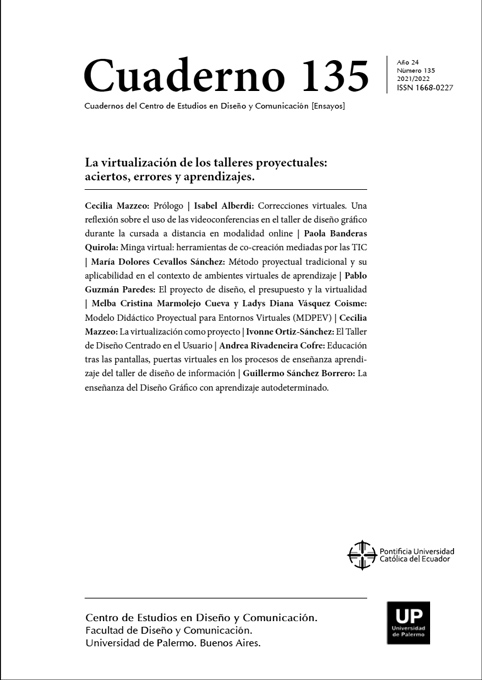El Taller de Diseño Centrado en el Usuario
Abstract
This paper aims to present the User–Centered Design workshop (TDCU), analyze his theoretical, pedagogical, and methodological proposals developed during the teaching experience on course and a the develop of the User centered project. The pedagogical and methodological strategies applied on the design teaching will be analyzed in detail focusing on obtained results, successes and errors during the four academic periods, on face to face and virtual lessons, since this workshop was stablished. It is articulated on a review of the Product Design career history, the construction of the pensum redesign that generated the workshop and a explanation of the structure of the course. The pedagogical principles based on the cognitivism that are being applied will be developed and the methodological proposal stated on this learning and teaching processes will be explained. Finally, once the framework is presented, it will discuss the applied strategies to the virtualization of the class: faced challenges, positive points and mistakes in order to analyze and conclude the future of the course.
References
Antunes, P.; Cunca, R. (2019). Product Innovation: A Collaboration between Sciences and the Arts. Convergencias, revista de investigación y enseñanza de las artes.
BECERRA, Ovídio Rincon (2016). Ergonomía y procesos de diseño: Consideraciones metodológicas para el desarrollo de sistemas y productos. Bogotá: Pontificia Universidad Javeriana.
Brandes, U., Stich, S.; Wender, M. (2013). Design by Use: The Everyday Metamorphosis of Things. Basel: De Gruyter.
Claxton, G. (2001). Aprender: El reto del aprendizaje continuo. Barcelona: Paidós.
Duran, JC. (2004). Teorías del aprendizaje y modelos pedagógicos. Quito: Universidad Central del Ecuador
Grand, S., & Jonas, W. (2012). Mapping design research. Basel: Birkhäuser. IDEO (2009). Diseño centrado en las personas.IDEO (Firm). (2003). IDEO method cards. Place of publication not identified: IDEO.
Johnson, J. (2014). Designing with the mind in mind: Simple guide to understanding user interface design guidelines.
Johnson, J. (2010). Designing with mind in mind: Simple guide to understanding user interface design rules. Amsterdam [u.a.: Morgan Kaufmann/Elsevier.
Koskinen, I. K. (2012). Design research through practice: From the lab, field, and showroom. Waltham, MA: Morgan Kaufmann/Elsevier.
Kuniavsky, M., & Moed, A. (2012). Observing the User Experience: A Practitioner's Guide to User Research. San Diego, CA, USA: Elsevier Science & Technology Books.
Lupton, E., Carpentier, T., & Lambert, T. (2014). Beautiful users: Designing for people. New York: Princeton Architectural Press - Cooper Hewitt, Smithsonian Design Museum.
Lidwell, W., Holden, K., Butler, J., & Safari, an O'Reilly Media Company. (2010). Universal Principles of Design, Revised and Updated. Maeda, J. (2006). The laws of simplicity. Cambridge, Mass: MIT Press.
Martin, B., & Hanington, B. M. (2018). The pocket universal methods of design: 100 ways to research complex problems, develop innovative ideas and design effective solutions.
Marín, T. J. M., & Torrent, R. (2016). Breviario de diseño industrial: Función, estética y gusto. Madrid: Cátedra.
Moggridge, B. (2007). Designing interactions. Cambridge, Mass: MIT Press.
Norman, D. A. (2016). Living with complexity.
Norman, D. A. (2007). Emotional design: Why we love (or hate) everyday things. New York: Basic Books.
Pratt, A., & Nunes, J. (2013). Diseño interactivo: Teoría y aplicación del DCU. Barcelona: Oceano.
PUCE (2018). Documento del Rediseño de la Carrera de Diseño de Productos. Quito. PUCE
PUCE (2019). Documento del Ajuste del Rediseño de la Carrera de Diseño de Productos. Quito. PUCE
PUCE (2021). Sílabo del Taller de Diseño Centrado en el Usuario. Quito. PUCE
Rodríguez, M. L. (2010). Diseño: Estrategia y táctica. México: Siglo XXI
Rubin, J., & Chisnell, D. (2008). Handbook of usability testing: How to plan, design, and conduct effective tests. - Includes index. Indianapolis, Ind: Wiley Pub.
Technische Hogeschool Delft. (2017). Delft design guide.
Wender, M., Brandes, U., & Stich, S. (2013). Design by Use: The Everyday Metamorphosis of Things. (Design byuse.) Basel: De Gruyter.
Los autores/as que publiquen en esta revista ceden los derechos de autor y de publicación a "Cuadernos del Centro de Estudios de Diseño y Comunicación", Aceptando el registro de su trabajo bajo una licencia de atribución de Creative Commons, que permite a terceros utilizar lo publicado siempre que de el crédito pertinente a los autores y a esta revista.


